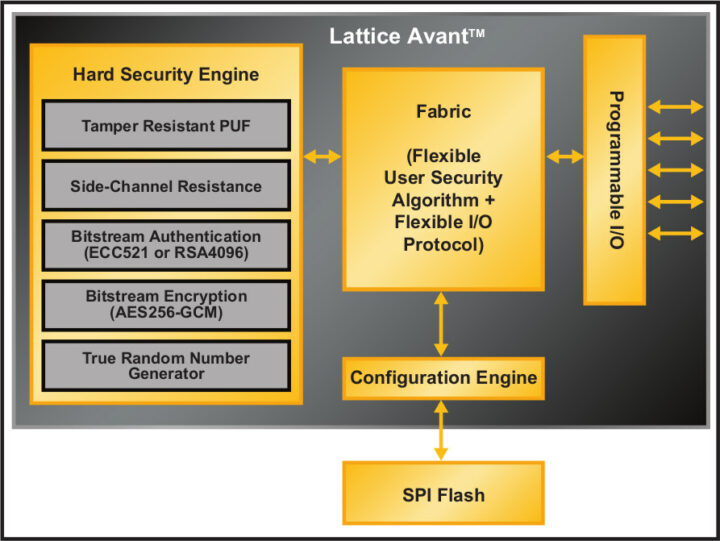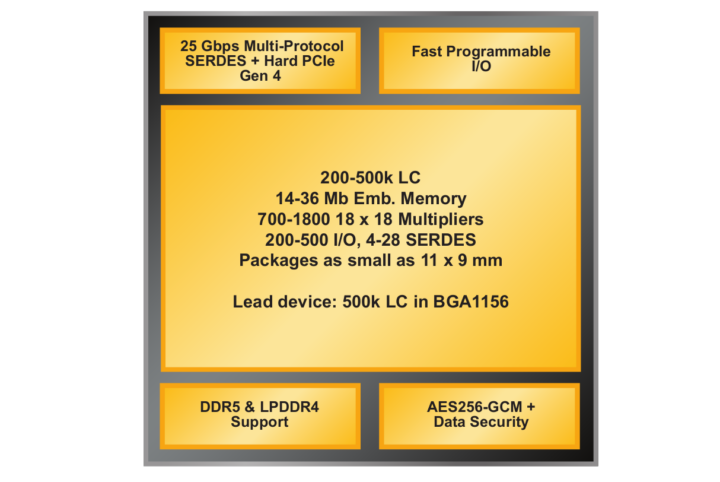Lattice Avant is a new low-power and small form factor mid-range FPGA platform, manufactured with a 16nm FinFET process, and equipped with 25 Gb/s SERDES, hardened PCI Express, external memory PHY interfaces, a high DSP count, and a security engine.
Lattice Semi is better known for its entry-level FPGAs such as the iCE40 which is popular in the community thanks to low-cost hardware and support for open-source tools, but the Avant platform marks the company’s entry into the mid-range FPGA market, defined by chips with 100k to 500k logic cells (LCs).
Lattice Avant highlights:
- FPGA fabric – 200K to 500K logic cells up to 350 MHz
- DSP – 700 to 1,8000 18×18 multipliers @ up to 650 MHz to support the latest AI algorithms
- Memory
- 14-36 Mbit embedded memory up to 650 MHz
- DDR3L/DDR4/LPDDR4 and DDR5 support
- I/Os
- 4x to 28x 25 Gbps multi-protocol SERDES
- Hard PCIe Gen4
- 200 to 500 I/Os
- Security engine with AES256-GCM encryption, ECC521 or RSA4096 authentication, tamper-resistant PUF, side-channel resistance, TRNG
- Lower power than similar class competitive devices thanks to a four-input LUT implementation, a reduction in high-capacitance nets, and the low-leakage 16nm process
- Package (Avant-E family)
- 11 x 9 mm for 200k LC
- 15 x 13 mm (BGA1156) for 500K LCs

Lattice Semi will provide the Lattice Radiant and Lattice Propel tools that include compiler optimizations and analysis to let users develop FPGA applications on the Avant FPGAs more easily. Lattice Avant is also said to come with a suite of IPs either hardened (custom logic) configurations for optimized area and performance, or in soft format (through the use of logic cells) for more flexibility.
The Avant FPGAs are expected to be used in networking controllers, PLCs, Edge computers, machine vision, industrial robotics, automotive networking and software-defined radio, as well as indoor 5G small cells and 5G fronthaul applications.
The company has a few demos with the Avant FPGA including a power consumption comparison against Intel Arria V and Xilinx Kintex-7 FPGAs, which shows the competing solutions consume 2.3 to 2.5 times more power. The Lattice Avant FPGA performance is also up to twice as fast as similar devices and comes with an up to six times smaller package. Lattice Semi claims this was made possible as competitors do not focus on the mid-range, using high-performance designs with a smaller logic cell count and less memory capacity, while they optimized the Avant FPGA specifically for mid-range use cases.
Besides just announcing the Avant platform, Lattice introduced the Avant-E FPGAs available in industrial and commercial grades with three SKUs: Avant-AT-200E, Avant-AT-300E, and Avant-AT-500E.
What’s unclear to me is when those FPGAs will be broadly available, as right now the company asks interested companies to contact their sales representative. More details may be found on the platform page, the Avant-E product page, and the press release.
Thanks to TLS for the tip.

Jean-Luc started CNX Software in 2010 as a part-time endeavor, before quitting his job as a software engineering manager, and starting to write daily news, and reviews full time later in 2011.
Support CNX Software! Donate via cryptocurrencies, become a Patron on Patreon, or purchase goods on Amazon or Aliexpress






